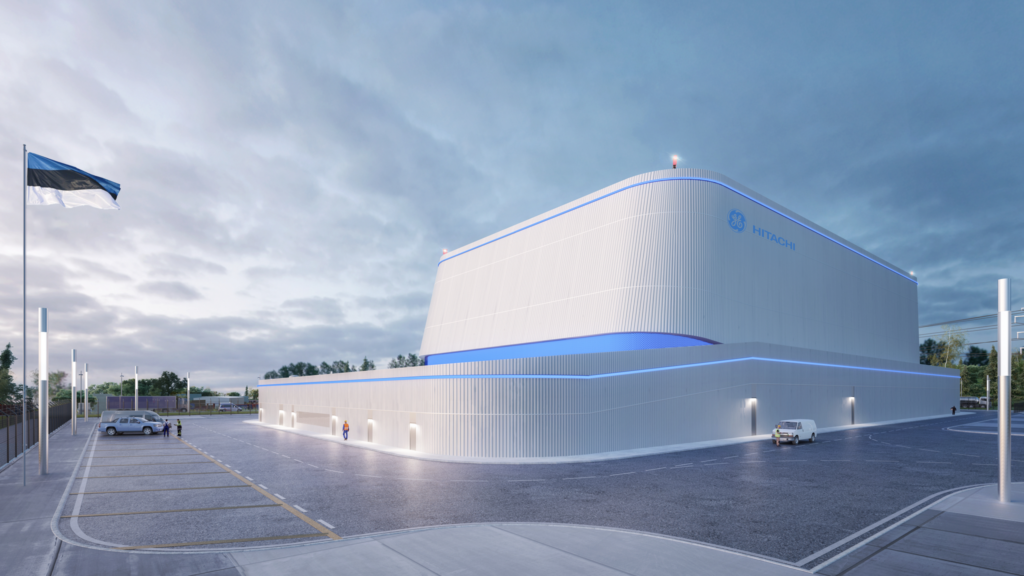 Estonia's privately held nuclear energy company, Fermi Energia, has chosen GE Hitachi Nuclear Energy's (GEH's) BWRX-300 small modular reactor (SMR) for deployment in Estonia by the early 2030s.
Estonia's privately held nuclear energy company, Fermi Energia, has chosen GE Hitachi Nuclear Energy's (GEH's) BWRX-300 small modular reactor (SMR) for deployment in Estonia by the early 2030s.
In 2022 Fermi Energia had accepted tenders from US-Japan joint venture GE Hitachi, US-based NuScale and the UK’s Rolls-Royce. Fermi Energia said the criteria for selection were technological maturity, establishment of a reference plant, economic competitiveness and participation of Estonian companies in the supply chain.
Fermi Energia was founded by Estonian energy and nuclear energy professionals specifically to develop deployment of SMRs in Estonia. In July 2019, the company launched a feasibility study on the suitability of SMRs for Estonia's electricity supply and climate goals beyond 2030. This followed a financing round from investors and shareholders. At that time, four SMR designs were included in the feasibility study: Moltex Energy SSR-W300, Terrestrial Energy IMSR-400, GE Hitachi BWRX-300 and NuScale SMR.
The BWRX-300 design is a 300 MWe water-cooled, natural circulation SMR with passive safety systems. It is the 10th evolution of GE’s boiling water reactor (BWR), hence the “X” in its name. The design is based on the Generation III+ 1,520MWe ESBWR, which the US Nuclear Regulatory Commission certified in 2014. The BWRX-300 is currently undergoing a Canadian Nuclear Safety Commission Pre-licensing Vendor Design Review and a US Nuclear Regulatory Commission Pre-application design review.
In January, GEH, Ontario Power Generation (OPG), SNC-Lavalin and Aecon signed a contract for the deployment of a BWRX-300 SMR at OPG's Darlington site. In August 2022, the Tennessee Valley Authority began planning and preliminary licensing for potential deployment of a BWRX-300 at the Clinch River Site in Tennessee. In June 2022, Canada's SaskPower selected the BWRX-300 for potential deployment in Saskatchewan in the mid-2030s. In addition, Poland’s ORLEN Synthos Green Energy (OSGE) plans a fleet of BWRX-300s, aiming to deploy the first by 2030. GEH has also begun the design certification process for the BWRX-300 in the UK.
"The BWRX-300 is a boiling water reactor based on its operating principle, which is used and well known by many European countries, including Finland and Sweden,” said Fermi Energia CEO Kalev Kallemets. “However, the specific reactor model is much smaller than the ones used in the nuclear plants of our northern neighbours, which allows for greater safety and reduced cost and time. At the same time, it is still possible to rely on the experience of our neighbours and to offer the consumer clean electricity at an affordable and stable price."
He added: "The choice of BWRX-300 by Polish, Swedish and other European companies gives assurance that the competence and supply chain of the selected technology will be sufficient in Europe."
"There are dozens of new SMRs in development around the world – each of them different in some way,” said Marti Jeltsov, Chief Technology Officer of Fermi Energia. “Some developers are experimenting with more exotic technologies that will take a long time to reach market maturity, while others use tried and tested, functional and safe solutions. Estonia cannot be too bold an experimenter with its first nuclear power plant. It also set a number of practical criteria for the choice of technology which, after thorough consideration, fell to GE Hitachi."
GEH and Fermi Energia have worked together since signing an agreement in 2019 to collaborate on potential deployment applications for the BWRX-300. In 2021 this was followed by a teaming agreement to work together in key areas including licensing support and supply chain development. "By leveraging a unique combination of existing fuel, plant simplifications, proven components and a design based on an already licensed reactor, the BWRX-300 offers cost-competitive zero-emission generation in a meaningful timeframe," said GEH President & CEO Jay Wileman.
Before nuclear construction can begin in Estonia, a positive decision is required from the Riigikogu (parliament) as well as the initiation of a special national plan to find a suitable location for the plant and the development of nuclear energy legislation. "We have analysed all the work ahead and consider it realistic to produce reliable, clean and affordable nuclear energy in Estonia by Christmas 2031, which should also be in the interest of society and the country's climate goals,” said Kallemets. “Understandably, this goal requires a serious effort from both the state and Fermi Energia."
Image: Artist's impression of a BWRX-300 plant (courtesy of GEH)






